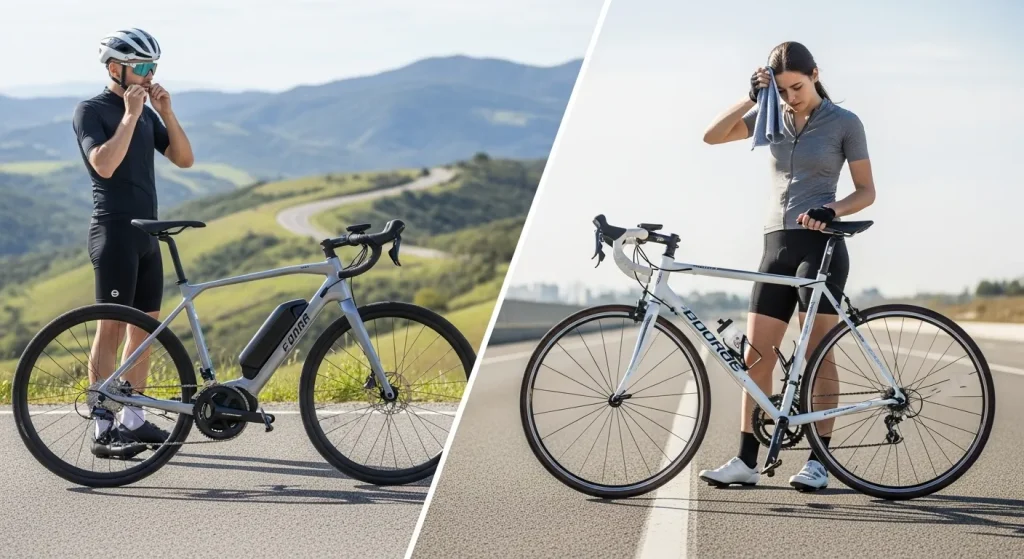E-Bike vs Regular Bike: Real Costs & Benefits Compared 2025
Speed and effort top the list when you’re stuck between buying an e-bike or a regular bike. E-bikes can zip along at speeds up to 28 mph and this cuts your commute time substantially. The bikes pack a 500 Watt (sustained) 750 Watt (peak) motor that pushes you forward without breaking a sweat, making those tough uphill climbs feel like a breeze.
Regular bikes depend on your leg power alone, but e-bike benefits go way beyond just being faster. Your daily commute could look completely different as these bikes make hills feel flat and trips shorter. The e-bike’s battery life is impressive too – you can cover 60 to 120 km on one charge, and it only takes three to five hours to juice up fully.

This piece will lay out all the costs and perks of both choices. You’ll see everything from what you pay upfront to value over time, how they affect your fitness, and what it’s like to use them day-to-day. By the time you finish reading, you’ll know exactly which bike matches your lifestyle, fits your budget, and helps you hit your personal targets in 2025.
Cost Breakdown: Upfront, Maintenance, and Long-Term

Initial Purchase Price
The e-bike versus regular bike comparison goes well beyond just looking at price tags. A standard bicycle costs anywhere from $200 for simple models to over $3,000 for premium options. Electric bikes cost more, starting at $1,000 for basic models and can go above $5,000 for high-performance versions.

Why E-Bikes Cost More
These higher prices come from e-bikes’ extra parts – lithium-ion batteries ($500-$1,000), motors ($200-$800), and electronic controllers. Most riders find quality electric bikes in the $1,500-$2,000 range work best for them.

Maintenance and Replacement Costs
Regular bikes need about $100 yearly for maintenance, while e-bikes cost $150-$300 each year to keep running. E-bike owners should plan for battery replacement ($500-$800 every 3-5 years) and motor servicing ($100-$200).

Running Costs and Daily Savings
Running costs for electric bikes stay surprisingly low. A complete battery charge runs about 8 cents, which adds up to roughly 60 cents monthly for regular commuters.

Long-Term Financial Benefits
E-bikes can save you money over time. Riders who switch from cars save $500-$1,500 yearly on fuel, parking, and insurance. E-bikes don’t need license registrations, taxes, or insurance by law.

Depreciation and Resale Value
The biggest problem? E-bikes lose their value faster, dropping 30-40% within two years while traditional bicycles only lose 20-30%.
Fitness and Health: Effort vs Accessibility
The fitness debate between e-bikes and regular bikes boils down to intensity versus consistency. Regular bicycles give you higher-intensity workouts. Riders burn about 505 calories per hour compared to 344-422 calories on e-bikes. Traditional cycling burns 30% more calories per session. Regular bikes might give you a tougher workout, but e-bikes have some surprising health benefits. Research shows e-biking qualifies as moderate-intensity physical activity. Your heart rate and breathing increase enough to get meaningful cardiovascular benefits. E-cyclists maintain heart rates at 94% of conventional mountain bikers.
The real advantage comes from how often people ride. E-bike users cycle more frequently and go 50% further. This extra riding time means both groups get similar weekly exercise. A large study of 10,000 people showed that e-cyclists and traditional cyclists got almost identical amounts of moderate-intensity physical activity each week. E-bikes are available to people with joint problems or limited fitness by reducing strain on muscles and joints. Riders can build confidence gradually while improving their heart health.
Your goals should determine which bike you choose. Traditional bikes give you maximum intensity per session, while e-bikes help you stay consistent through easier rides that you’ll enjoy more.
Commuting and Daily Use: Speed, Convenience, and Safety
E-bikes show their real worth during daily commutes and routine travel. They multiply your pedal power and let you maintain higher average speeds (15-28 mph) without getting drenched in sweat. Urban trips under 10 miles become easier as riders can bypass rush hour congestion by using bike lanes and avoiding parking searches.
Different classifications determine an e-bike’s speed capabilities. Class 1 and 2 e-bikes assist up to 20 mph, while Class 3 models can reach 28 mph. These faster speeds can cut commute times by 30-50% compared to driving or public transit. The electric assistance makes hills and headwinds barely noticeable.
E-bikes’ speed and mass can lead to more severe injuries than conventional bikes. The number of e-bike-related injuries in the U.S. jumped from 751 in 2017 to 23,493 in 2022. Class 3 riders must wear helmets by law, though all riders should consider wearing one. Theft risk remains the biggest concern due to these bikes’ higher value. Riders should secure both wheels and the frame to immovable objects. Many owners also register their bikes with databases like Project529 to help recover stolen bikes.
E-bikes combine smoothly with public transit systems and help decrease greenhouse gas emissions and urban noise levels. This mix of speed, convenience, and environmental benefits explains why many commuters now choose electric bikes for their daily travel.
Comparison Table
|
Feature |
Electric Bike |
Regular Bike |
|---|---|---|
|
Original Cost |
$1,000 – $5,000 |
$200 – $3,000 |
|
Annual Maintenance |
$150 – $300 |
$100 |
|
Maximum Speed |
Up to 28 mph |
Not mentioned |
|
60-120 km per charge |
Not limited by battery | |
|
Charging Time |
3-5 hours |
N/A |
|
Calories Burned/Hour |
344-422 calories |
505 calories |
|
Value Depreciation |
30-40% in 2 years |
20-30% in 2 years |
|
Additional Costs |
– Battery replacement ($500-$800 every 3-5 years) – Motor servicing ($100-$200) – Electricity (8 cents per charge) |
No additional electronic components |
|
Commute Benefits |
– Reduces commute time by 30-50% – Flattens hills – Minimal sweating – Speeds up to 28 mph |
– Higher intensity workout – No battery dependency – Lower maintenance needs |
|
Safety Aspects |
– Higher injury risk due to speed and mass – Higher theft risk due to value |
Lower injury and theft risk |
|
Fitness Level Required |
Suitable for all fitness levels |
Requires more physical effort |
Conclusion
The choice between e-bikes and regular bikes really comes down to your lifestyle and priorities. E-bikes are ideal for commuters, they flatten hills, cut travel time by up to 50%, and make daily rides easier. While the $1,000–$5,000 price tag (plus maintenance) can be a hurdle, the long-term convenience and savings often make up for it. Regular bikes are great for fitness-focused riders and those on a budget. They cost less, hold their value longer, and require minimal upkeep. While e-bikes help you ride more often and farther, regular bikes demand more physical effort per ride, great for workouts. You can learn about types of Electric bikes here.
Safety is also key: e-bikes are heavier and faster, so wearing the right gear is a must, especially on Class 3 models. Ultimately, there’s no one-size-fits-all answer. If you’re commuting, climbing hills, or replacing car trips, an e-bike could be your best investment. If you’re after simplicity and sweat, a regular bike might be the way to go. Ready to upgrade your ride? Check out the latest electric bikes at Tesla Bike Sales and find the perfect fit for your lifestyle.
